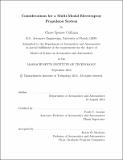Considerations for a multi-modal electrospray propulsion system
Author(s)
Coffman, Chase Spenser
DownloadFull printable version (2.098Mb)
Other Contributors
Massachusetts Institute of Technology. Dept. of Aeronautics and Astronautics.
Advisor
Paulo C. Lozano.
Terms of use
Metadata
Show full item recordAbstract
Micro- and nano-satellites have begun to garner significant interest within the space craft community as economic trends encourage a shift away from larger, stand-alone satellite platforms. In particular, CubeSats have emerged as popular, economic alter natives to traditional satellites which might also facilitate low-cost space access for academia and developing nations. One of the foremost remaining obstacles to the widespread deployment of these spacecraft is the lack of suitable propulsion, which has severely limited the scope of prior CubeSat missions. While these spacecraft have gained traction by virtue of their economical size, the same quality has imposed unique propulsion demands which have continued to elude traditional thruster concepts. The ion Electrospray Propulsion System (iEPS) is a microelectromechanical (MEMS) based electrostatic thruster for space propulsion applications. This technology makes use of ionic liquid ion sources (ILIS) and a porous emitter substrate to obviate the need for cumbersome ancillary components and achieve the spatial and power characteristics that could lend feasibility to active micro/nano-satellite propulsion. This thesis introduces the iEPS concept and highlights the characteristics that make it attractive as a means of CubeSat propulsion. Specifically, its bimodal propulsion characteristics are presented alongside a discussion of the constant power Isp modulation mechanism that makes this unique capability possible. A simple demonstration of the variable Isp concept is reported, and a brief exploration of the performance implications is used to suggest a direction for taking it to operational maturity.
Description
Thesis (S.M.)--Massachusetts Institute of Technology, Dept. of Aeronautics and Astronautics, 2012. Cataloged from department-submitted PDF version of thesis. This electronic version was submitted and approved by the author's academic department as part of an electronic thesis pilot project. The certified thesis is available in the Institute Archives and Special Collections. Includes bibliographical references (p. 71-73).
Date issued
2012Department
Massachusetts Institute of Technology. Department of Aeronautics and AstronauticsPublisher
Massachusetts Institute of Technology
Keywords
Aeronautics and Astronautics.